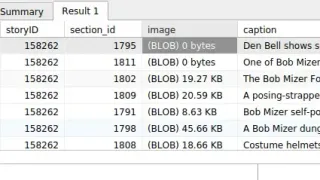July 4, 2015
SF Dyke March Breaks Out, Reclaims Route
Kilian Melloy READ TIME: 7 MIN.
To the sound of drums and chants of "Whose streets? Our streets!" thousands of women broke away from the planned route of the annual Dyke March and crossed police lines to follow the traditional route that passes lesbian community landmarks.
The march, on June 27, was scheduled to start at an earlier time and take a different route than usual, proceeding a block farther on Dolores Street and turning onto 17th rather than 18th Street toward Valencia.
A group of several hundred women organized to reclaim the traditional route, marching behind a large "Dyke Power" banner. Many more, having heard of the plans on social media, gathered around the intersection of 18th and Dolores waiting for the breakaway group.
The growing group moved through a line of about a dozen police officers on foot blocking 18th Street, after which a second line of police on motorcycles moved aside. Once the breakaway group turned onto 18th, a majority of the thousands of women in the remaining line-up followed. Marchers removed metal barricades blocking access to Guerrero Street and continued on to Valencia Street, where they rejoined the planned march route.
Small but Significant
While the change in the route was small - differing by only three blocks - for many it carried important historic significance.
The Dyke March, first held in June 1993, has traditionally gone past the Women's Building, the former site of the lesbian bar Amelia's, and Good Vibrations. The owners of what is now the Elbo Room at Valencia and Sycamore put up the old Amelia's sign each year for the march. But the building is being redeveloped as condos and the Elbo Room is expected to close this fall, likely making this the last year the sign will be changed.
"Something needed to be organized because so many people are grieving the loss of space in the city and didn't know where to put that energy," said Joey "Cupcake" Stevenson, who spearheaded organizing of the breakaway march. "It happened really quickly and I'm pleased by the level of dyke competency ... We're a community of pissed-off, seasoned activists."
Activists said the housing crisis and displacement led to the formation of the breakaway group.
"The decision to reroute the official Dyke March route off of 18th street and away from historic institutions like the Women's Building and the former Amelia's bar comes in the midst of an affordable housing crisis that is displacing our dyke community, friends, and neighbors," according to a statement issued by the breakaway group. "The future of San Francisco's dyke community is bound up in a larger struggle for racial and economic justice. Being queer women means fighting homophobia, racism, misogyny, transphobia, and ableism."
Changes cause Controversy
The Dyke March kick-off time was changed from evening to mid-afternoon to coincide with the new Pink Party in the Castro, according to march organizers.
The march has traditionally concluded around sunset at 16th Street and Market as marchers join the ongoing street party, formerly known as Pink Saturday. As previously reported, the San Francisco LGBT Community Center took over the Pink Party this year after the Sisters of Perpetual Indulgence withdrew due to growing violence and lack of city support. The new organizers hoped ending the party before dark would minimize problems.
"The Pink Party ended earlier, which meant we had to start earlier if we wanted to land somewhere," Dyke March committee chair Elizabeth Lanyon told the Bay Area Reporter. "In the future, this consideration may be an opportunity to march to a landmark or pick a different destination so there is more flexibility on time."
The change in the route sparked more questions and more controversy.
Ingrid Nelson and Greta Christina shared a kiss under parasols during the afternoon rally at Dolores Park that preceded the Dyke March. Photo: Jane Philomen Cleland
Due to uncertainty about the status of Dolores Park renovations when planning began late last year, the organizing committee - a multigenerational group of six women volunteers from San Francisco and the East Bay - decided to get a permit for a street party centered on the intersection of Dolores and 18th streets. They made the decision to locate the sound truck, which also serves as a stage, at the northwest corner.
As it happened, the north side of the park opened and the south side - traditionally considered the gay area - was fenced off just a week prior to the march for renovations in that section. Park officials, trying to preserve the new lawn, did not allow infrastructure such as a stage in the park. But there was never a prohibition on Dyke March and Trans March participants hanging out on the grass during the pre-march parties.
"The reason for the route change was about safety," said Lanyon, who has worked on the march for three years and attended for about 10. "Moving the truck to the other corner was a strategic decision to draw participants to the open side of the park. Turning the truck around in that intersection to march [on 18th] would have been a logistical and safety nightmare."
The final decisions about the march time and route were made by late May - as reported on social media sites and the B.A.R. 's blog - but most community members did not hear about the change until a few days prior to the march.
Many were skeptical about the march organizers' explanation for the change, attributing it to pressure from local businesses, city officials, and the San Francisco Police Department.
"I know a lot of folks don't like that answer, but that's the truth - no one made any decisions for us except us," Lanyon stressed. "No business owners nor politicians had anything to do with the route change."
Farina, a high-end Italian restaurant across 18th Street from the Women's Building, was the primary target of the rumors.
Farina manager Gabriele, who declined to give his last name, told the B.A.R. that the management did not have anything against the march. "We are for human rights and respect the community," he said. He added that the restaurant had changed ownership earlier this year and is now owned by a global corporation.
Gay Supervisor Scott Wiener, whose district includes Dolores Park, said he didn't know anything about pressure to change the route. San Francisco Police Captain Dan Perea's office at Mission station did not return the B.A.R.'s call by press time.
"The route change was in no way a jab at the historical richness of Dyke March," Lanyon explained. "We did realize the importance of marching past the historic landmarks, however we did not anticipate the backlash from doing things differently for one year. We could have done more outreach on the route, in hindsight."
Kicking off the march from the sound truck on Saturday, Lanyon stated, "No man has ever made decisions for the Dyke March, and no man ever will."
Response to Displacement
In the days preceding the march, rumors began to circulate and anger built up as questions and comments about the route change posted to the Dyke March Facebook page were deleted by page moderators.
A number of women activists independently had the idea to reclaim the original march route. Stevenson, a hair stylist at Glama-Rama, said she heard about the route change at work and "connected the dots" between people who wanted to respond. A newly created "Take Back the Dyke March" Facebook page soon had more than 1,000 people saying they planned to participate.
"People are so pissed off about loss of space and living under the threat of eviction," Stevenson told the B.A.R. "My first dyke march in 1996 or 1997 was really radical, really moving, and really powerful. Saturday's march included a lot of people who were not politicized and haven't done anything like that before. It was a moment for a movement. I hope it was just the beginning of radical dyke culture again."
Adele Carpenter, another breakaway march organizer, concurred.
"There's a real sense of desperation," Carpenter said. "Queer women have been watching our friends and community members be displaced from the city at an alarming rate, and the reroute of the march away from some of our last standing lesbian community institutions really hit a nerve with a lot of people. We don't have our bars anymore. So many of us are losing our apartments. There was this very clear urgency around needing to take our public space last Saturday."
The theme of reclaiming dyke space extended beyond the physical route, as an overlapping group of women came together in an attempt to remove the growing number of men from the march.
"For a lot of queer people, San Francisco is the only place where we have felt like we truly belonged," said Pike Long, who helped organize the affinity group. "As gentrification rapidly devours all that we have built up, brick by brick for decades, it feels especially wrenching that even the few things we have left are being taken away from us. The Dyke March represents a radical reclaiming of space by queer women, and sometimes our allies. It's the one day of the year where women should be able to take up space and have fun with each other free from the leering of cisgender straight men."
While the decisions around the route change and the breakaway march have left some unanswered questions and hurt feelings, most agreed that the action was powerful and expressed hope that it would lead to more women getting involved in organizing the Dyke March in the future.
"The Dyke March requires an incredible labor of love and I really appreciate the work of the organizing committee," said Amanda Ream, another organizer of Take Back the Dyke March. "But it's not a parade, it's a march. Dykes successfully took our space and will be taking it again next year and in the years to come in San Francisco. I hope that many people who were politicized around the closing of the Lexington Club will join in organizing next year with the Dyke March committee."
"They had great momentum bringing together that many people in so little time," Lanyon said of the breakaway group. "This is the type of activism Dyke March needs to keep current."
Kilian Melloy serves as EDGE Media Network's Associate Arts Editor and Staff Contributor. His professional memberships include the National Lesbian & Gay Journalists Association, the Boston Online Film Critics Association, The Gay and Lesbian Entertainment Critics Association, and the Boston Theater Critics Association's Elliot Norton Awards Committee.





